Everdell and more specifically the artwork in Everdell by Andrew Bosley is incredibly pretty and thematic.
I was sent the Collectors Edition for review. Sending me a product does not change my opinion and you should know me well enough to know that I will burn bridges to be able to tell you the truth about any product as my only loyalty is to honesty.
I want to say this now and get this part of the review out of the way because the aesthetics can and will get in the way when you try to objectively review the game.
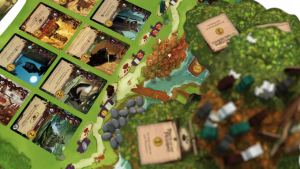
For example, the Ever Tree which stands tall at the back of the board and makes Everdell stand out amongst other worker placement games is actually a bad idea.
Sure it does make the game look fabulous and it has a practical application but on the flip side, it becomes an annoyance when you try to play with four players. It means you have to adjust your seating arrangement so that no one is sitting behind or too far to the side of the tree.
Placing your city in a 3 X 5 configuration looks amazing but takes up an incredible amount of space so your seating arrangements, which allow everyone to see the cards and workers on the tree, will be awkward to manage and leave you feeling like your enormous dining table could do with being a few feet larger so your city isn’t butting directly into someone else’s.
So actually, that is the negative thing about Everdell dealt with and despite these, easily solvable flaws, Everdell is, in my honest opinion, a must buy.
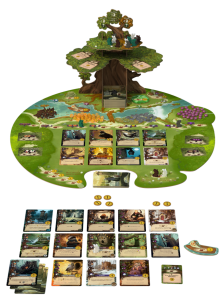
I know this review is all over the place and I have already summed up and hit you with a slew (well two) negatives but I wanted to get this stuff out of the way so I can tell you all what a wonderful game Everdell is.
In the collector’s edition, you get some nice little extras such as wooden occupied tokens and instead of punched card (which is also included) point tokens you get real metal coins as well as some extra cards to enhance the game and a very pretty sleeve to cover the box.
After being awestruck by the artwork the next thing you feel is the quality of the components. The Resin, Pebbles, Twigs and Berry’s feel incredible, pebbles have a nice “chink” when you place them down that makes it feel like real stone and the berries are made of some sort of squishy resin. The twigs and resin are plastic and are shaped to resemble the item they represent.
The quality of the board is first-rate and even though the Ever Tree is made from the card it feels like great quality, I do worry that if you play a lot it would eventually begin to wear when setting up and breaking down the game but I am sure it would last a good deal of time.
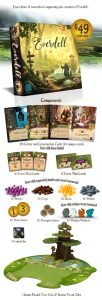
The workers are represented by coloured and shaped wooden tokens Hedgehogs, Squirrels, Mice and Turtles respectively.
The cards have a linen feel and when you shuffle the enormous deck together there is a satisfying rumble as the texture of each pass each other.
The tactility of the components coupled with the artwork and theme make Everdell a real treat to touch and play.
The game is played over a series of seasons. You start the game in Winter and move through, Spring, Summer and finally Autumn.
In the first phase, you have two workers and will inevitably be collecting resources for your first turns so you can place a construction before readying yourself for the next season.
As with all games of this type, the start of the game is always quite a light affair with little to do and no really tricky decisions to make but as the seasons pass and you have more workers, more options and ultimately more choices you will find that Everdell is a strategically deeper game than its appearance belies.
When you have the resources, you will be able to begin building your city. The cards fall into two categories, Construction or Critter and there are a total of 128 in the collector’s edition. These cards are broken down into 5 further card types which are denoted by an icon.
A green icon with a shoot indicates a production card. These cards activate immediately when played and again during the preparation phase for spring and Autumn.
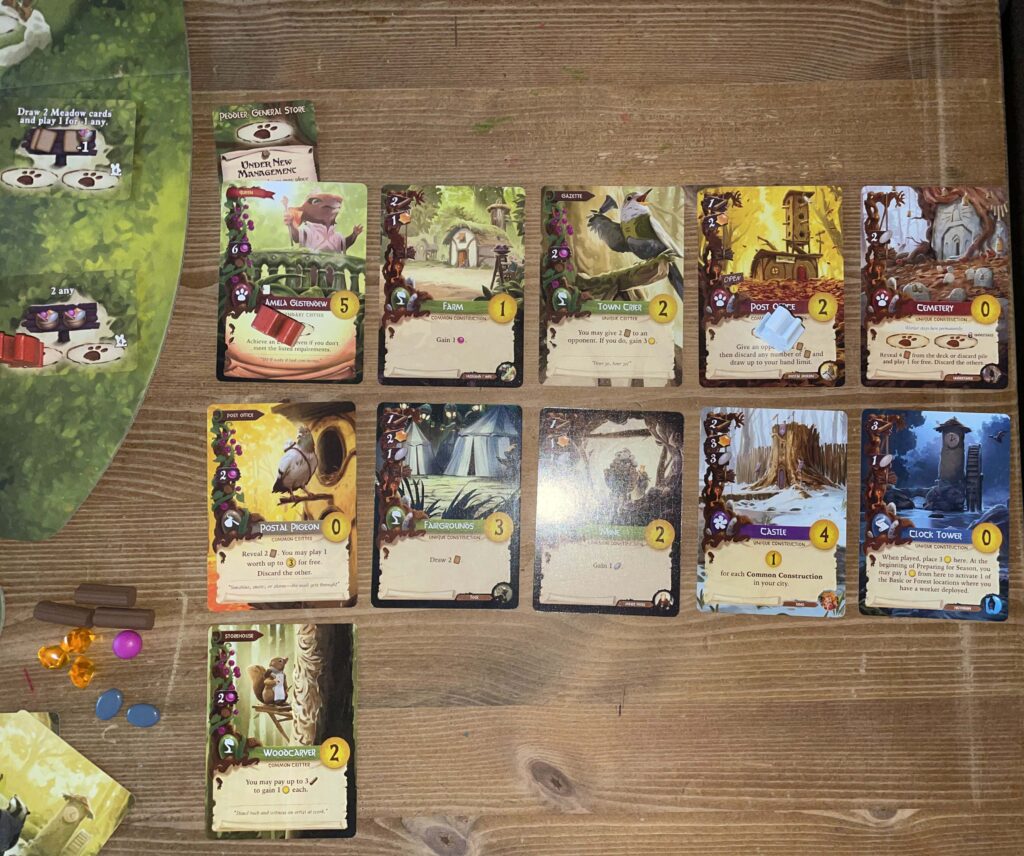
A red icon with a paw indicates a destination. These cards activate when you place a worker there. These can again be broken into two separate types, Open meaning anyone can place a worker there or, I was going to say closed but it’s just the other one and only you can place your workers there.
A tan icon with a knapsack is a traveller card. This activates when you play it and never again.
A blue icon with a scroll indicates a Governance card and with these cards, you can apply a bonus when you play certain cards or get a discount on others.
A purple icon with a flower is a prosperity card. These are worth the base points listed but equally will grant you bonuses at the end of the game.
Depending on the number of players you will start the game with between 5 and 8 cards in your hand but can never hold more than this. There are also 8 cards placed face up in the meadow, an area in the centre of the board, that are communal and you can play these as though they are in your hand but only if you have the ability to play it immediately on picking it up.
These cards are replaced as soon as they are taken but the only other way to increase the number of cards in your hand is to use an action on a location offering cards or to play a card with an instruction to do so.
You can place your worker on any location to complete the action there with some places open only if you have met the requirements.
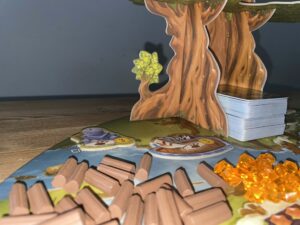
There are 4 forest locations where you will be able to gather twigs, resin, pebbles and berries with a couple of these spots also allowing you to draw cards. These locations have a closed and open spot each. The closed location allows only one player to visit and rewards them with more resources, the second spot in each is open and gives fewer resources but any number of workers can visit with the caveat that only one of your workers can be there.
There are also Destination cards that allow you to place workers in cities, Event locations that require you to have met some criteria, for example, the Grand Tour is only available if you have 3 destination cards in your city.
There is the Haven, a place you may discard cards in exchange for resources and finally, in Autumn you can visit the Journey and discard cards to gain up to 5 points.
When you set up you also place four forest cards at random and these also become a destination that will allow you to gather resources. During a 4 player game both of the spots on these cards will be open but in a solo, 2 or 3 player game one of these spots will be closed.
One of my favourite things about Everdell is that you don’t actually know who has won the game until you finish and add up your points. On many occasions, I was sure I had won only to find my wife had trounced me because of “reasons”. Those reasons are that she is smarter than me which I place in the category of cheating.
Playing a board game solo is something I never thought I would want to do but there are so many great games that work well solo it’s definitely an option for me now. Everdell is being added to my solo playlist which currently includes Descent, Star Wars Imperial Assault and Dune Imperium.
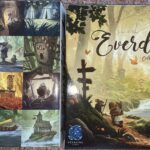
The solo game works because of the way it works and the randomness of a dice throw. There are a few things that grate as with any solo game because you are not actually playing against a thinking opponent and instead you’re playing against luck, well bad luck in my case. The game is again played through seasons but your foe, Rugwart the bastard, is controlled by rules and dice.
So, full disclosure, Rugwart the bastard is not his official name, his name is just Rugwart but be warned, he is a bastard.
You start with 5 cards in your hand and Rugwart has none, instead, on his turn, he can just play cards into stacks of their corresponding colour from the meadow by rolling a D8 and on top of that, you cannot go to a location where his minions are, he starts at the 3 twig spot and the top left forest card which means he is in your way from day one, the bastard.
As each round progresses, he moves his workers around the locations clockwise but on top of this he gradually takes up space in the meadow which means you will eventually be able to draw from the bottom row of cards only while he has access to all 8.
He also will gain event cards at an alarming pace as he gets the required number of cards of the correct colour in their corresponding stack.
At the end of the day, it is still a dumb AI but it is well done and can be quite a challenge to beat him. What I mean by that is that I have not played on the higher difficulties as I haven’t beat him yet but this is probably due to the fact that he is a bastard and has nothing to do with me not being good at Everdell.
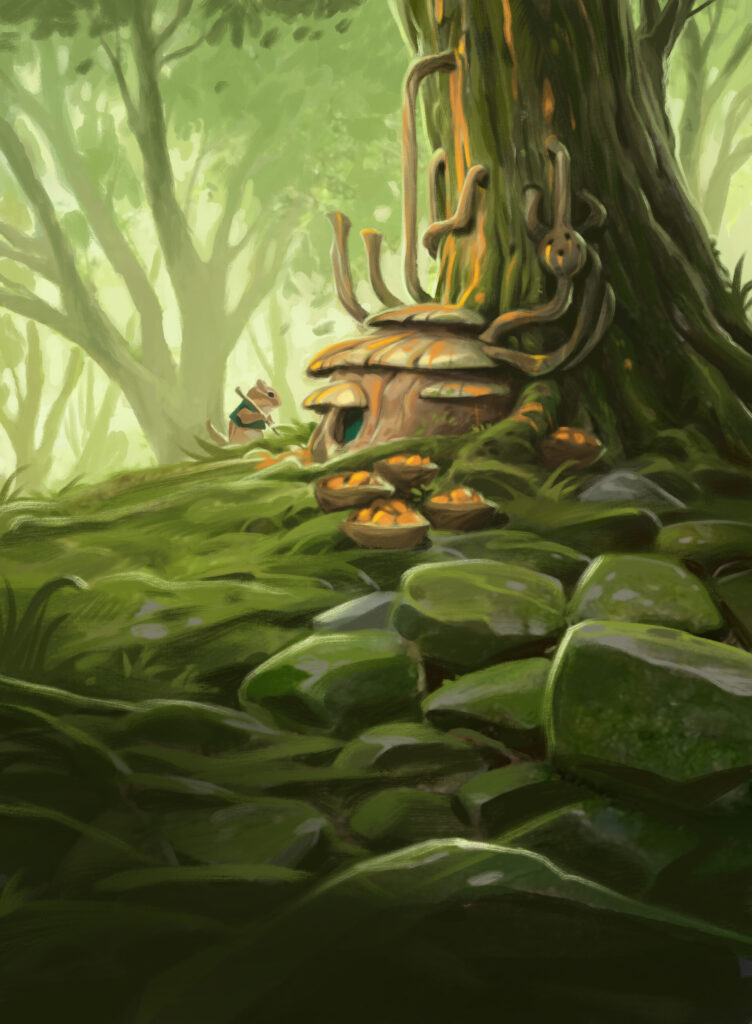
In Summary
Everdell is an excellent game. James Wilson has designed a great game that plays very well. It is light enough to pick up the rules very quickly but can get quite deep and strategic in the late game. The components are of the highest order and the collector’s edition steps this up with the addition of metal coins and wooden occupied tokens (although you still have to put stickers on them) but at almost double the price of the standard version you will need to decide how important this is to you because my recommendation is to have Everdell in your collection with whatever version is in your budget. It is one of our family favourites and my children can play it with no issues at 7 and 9 years old.

